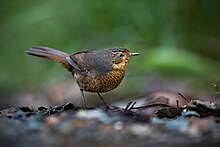|
Pilotbird
The pilotbird (Pycnoptilus floccosus) is a species of passerine bird in the family Acanthizidae. It is monotypic within the genus Pycnoptilus. The species is endemic to south-eastern Australia. TaxonomyThe species was first described by English ornithologist John Gould in 1851. The generic name Pycnoptilus derives from the Ancient Greek pyknos 'thick' and ptilon 'feather'.[3] Its specific epithet floccosus is Late Latin for 'flocked with wool'.[3] There are two subspecies: the nominate subspecies Pycnoptilus floccosus floccosus lives in alpine areas; and P. f. sandfordi lives in lowland forest.[4][5] DescriptionThe pilotbird is a large, plump species of acanthizid, measuring around 18 centimetres (7.1 in) in length and weighing 27 grams (0.95 oz).[4] The plumage of the underparts is reddish-brown with scalloping on the chest and the centre of the belly speckled dull white. The upperparts are chocolate-brown.[5][6] The bill is short and finely pointed.[7] Its tail is broad and semi-erect, and flicked up and down when feeding.[5][8] Distribution and habitatThe pilotbird is found from the Wollemi National Park and Blue Mountains National Park in New South Wales through to the Dandenong Ranges, near Melbourne in Victoria.[9] Its natural habitat is temperate wet sclerophyll forests and occasionally temperate rainforest, where there is dense undergrowth with abundant debris.[10][7] It is sedentary and common.[7] BehaviourIts name comes from its supposed habit of following lyrebirds, taking prey that they flush, and also from its call guiding bushmen seeking for lyrebirds.[7] This habit is well known but seldom observed. The pilotbird is highly terrestrial, feeding on or near the ground and when disturbed it runs swiftly on strong legs.[7] Its call has been described as "piercing and sweet".[8] The male makes a far-carrying call of wit-wit-weet-WHEER to which the female may respond with a softer wit-a-wit-ee.[7][8][4] BreedingThe breeding season for the pilotbird is from August to December.[7] The globular nest is built with a side-entrance and hidden amongst the accumulated debris on the forest floor.[7] It is an untidy construction of bark, ferns, dead leaves and rootlets.[8] A clutch of usually two eggs, each measuring 27 by 20 mm (1.06 by 0.79 in) and varying in colour from grey-green to purple-brown, is incubated by the female for 20–22 days.[7][8] During the nestling period, which lasts 14–17 days, the male will often feed the female or help with the care of the nestlings, if the female has a subsequent brood.[4] The nests are sometimes parasitised by the fan-tailed cuckoo (Cacomantis flabelliformis).[4] ConservationThe pilotbird is fairly common within its small range, which has reduced as a result of forest clearance and urban development, but much of its habitat is within national parks or reserves.[4] Its habitat is also threatened by climate change, severe weather and bushfires;[10] nevertheless, the most recent assessment in October 2016 classified the pilotbird as vulnerable on the IUCN Red List.[10] The pilotbird was listed as Vulnerable under the EPBC Act in 2022,[11] in response to the 2019/2020 Australian Bushfires, which burnt 47% of its distribution, and contributed to an estimated 30-50% decline in the population.[12] References
Wikimedia Commons has media related to Pycnoptilus floccosus. Wikispecies has information related to Pycnoptilus floccosus. |
||||||||||||||||||||||||||||||||||||||||



